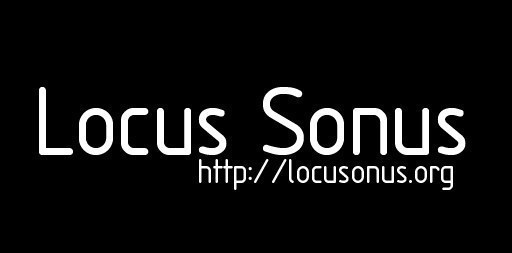|
This revision is from 2012/03/01 00:44. You can Restore it.
symposium #7
mar2012
Auditoriums Internet / Internet Auditoriums
LOCUS SONUS audio in art
http://locusonus.org/
LAMES MMSH Sociology Research Lab - University of Provence
http://lames.mmsh.univ-aix.fr/
24 & 25 march 2012
9am to 6pm
École Nationale Supérieure d'Architecture de Nantes
-- (School of Architecture of Nantes)
http://www.nantes.archi.fr/
24 march 2012
9pm, free entrance
Le Lieu Unique
in collaboration with LOCUS SOLUS, Rare music & Invented instruments
on the 17th and 18th of March, 2012, website.
http://www.lelieuunique.com/
ensa école nationale supérieure d'architecture nantes / school of architecture nantes
lieu unique
école supérieure d'art d'aix en provence / school of arts aix en provence
école nationale supérieure d'art de bourges / school of arts bourges
lames laboratoire de sociologie mmsh cnrs umr 7305 université de provence / sociology research lab university of provence
accord-cadre cnrs / ministère de la culture / cnrs research agency & french ministry of culture
ministère de la culture et de la communication / french ministry of culture
en partenariat avec
université laval québec / laval university quebec
crisap creative research into soundart practices, lcc, university of the arts london (uk)
rpi rensselaer polytechnic institute university of troy ny (usa)
saic school of the art institute of chicago (usa)
deutschlandradio kultur klangkunst berlin (all)
emerge experimental media research group bournemouth university (uk)
et
eso espaces et sociétés cnrs université de nantes / geography research lab spaces & societies university of nantes
gersa groupe d'étude et de recherche scénologique en architecture ensa nantes / research group on theater & architecture studies
laua langages actions urbaines altérités ensa nantes / research group on languages, urban actions & othernesses
apo33 nantes
|
menu
|
participants
| |
|
Alejo Duque
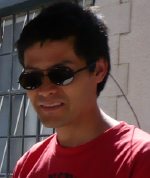 |
Rarae Aves - http://dorkbot.org/dorkbotmde/rebot/?TRUeQUE
Abstract :
Galileo destroyed geocentricism, but it got reconstructed by the unstoppable ambition for connectivity, command and control represented today by the 'saturnesque' ring of artificial geostationary satellites and space junk. And so the Earth became –once again– an immobile object in the centre of a medial universe.
An exercise inside the imperceptible realm of the waves of radioelectric frequencies. To spot and listen both geosynchronous and low elevation orbiters. To locate and observe, like the ornitologist, guided by sound and spectral analysis those victorian age technologies. As backdrop a soundscape captured with a VLF (Very Low Frequency) receiver to allow the listening pleasure of natural radio phenomena (+EMF contamination). With the intention of regaining access and control over free information infrastructures we take on a critical stand to reflect on the hegemonial manipulation articulated by the way of systems operating via tele-technologies. From war machine drones to the familiar tv set, in our particular case, we will concentrate on so called Satellites. To listen to them while they scan and transmit. To watch them while they measure. But most importantly to reconsider, rethink and reclaim their use. Be this a call to electronic civil disobedience, culture jamming or noise. We start at dusk by deploying UHF and S-band satcom antennas. Pointing at articular Azimuth and Elevation crossings so to catch them as the ornithologist do, by ear.
As we perform, we revisit the text of a forgotten 'love letter', one of those that never got to it's destination/address. Agambenian sensadestinazione. Signed by 8 equatorial countries in 1976 and called: The Bogota Declaration.
back to programme — back to participants
Alejandro Duque (Switzerland-Colombia) is an artist and a current PhD candidate at the European Graduate School (http://www.egs.edu) in Switzerland with research entitled: Gifted Malice, Kinship Through the Wires and the Waves. Alejo dedicates his free/libre time to experiencing all possible ways for collaborative/participatory arts that celebrate cultural agitation across all possible networks. His current interests deal with sound transmissions over HAM radio, streaming media and satellite listening (and spotting). Active member of networks such as Bricolabs, dorkbot, labSurlab and [k.0_lab] and is easy to find on the IRC freenode network @dspstv. He's member of Locus Sonus since 2008.
Alejandro Duque est un artiste colombien diplômé de l'École d'Art de Medellin en Colombie. Il est actuellement doctorant en thèse de Philosophie de la Communication en Suisse à l'EGS (European Graduate School http://www.egs.edu, Switzerland) et membre du laboratoire Locus Sonus. Sa recherche traite du piratage et de la manière dont les idées sont pillées sur les réseaux (sociaux, internet..) et comment des concepts de communautés marginales sont détournées et confrontées aux philosophies du monde occidental.
|
| |
|
| |
|
Grégoire Lauvin
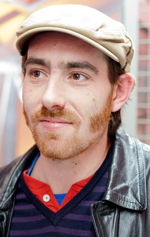 |
SplitSoundscape, biorama sonore
(SplitSoundscape, a sonic biorama
Abstract :
SplitSoundscape est un projet d’installation proposant une expérience originale de l’espace sonore. Une série de microphones est disposée dans un espace vaste, à l'échelle d'une ville par exemple. Le son de ces microphones est streamé en temps réel. Dans le lieu d'exposition, des haut-parleurs omnidirectionnels diffusent en direct les sons captés. La disposition des haut-parleurs dans l'espace d'exposition reprend, à l'échelle humaine, celle géographique réelle des micros, sous la forme d'une transposition réduite. Dans SplitSounscape, c'est le visiteur qui, en se déplaçant entre ces diffuseurs, créé le mixage entre les différentes sources sonores.
back to programme — back to participants
Grégoire Lauvin (1981) est un artiste plasticien et enseignant français, qui vit et travaille à Aix en Provence.
Diplomé de l'École Régionale des Beaux Arts de Bordeaux (France), de l'École Supérieure d'Art d'Aix en Provence (France) et ayant étudié à la School of the Art Institute of Chicago (USA), dans le Art & Technology department, il mène depuis 2007 de nombreux workshops sur la programmation et l'électronique créative, et, depuis 2011, enseigne ces disciplines et pratiques à l'École Supérieure des Beaux-Arts de Marseille. Il conçoit et réalise, pour lui-même ou d'autres artistes, des programmes et circuits électroniques, essentiellement destinés à la production artistique.
Fasciné depuis toujours par tout ce qui contient de l'électronique, il considère ces technologies comme un environnement naturel dans lequel il a grandi et qu'il a appris à utiliser empiriquement. Oscillant entre high-tech et low-tech, analogique et numérique, il conçoit des dispositifs poétiques dans lesquels la machine s'hybride avec des éléments vivants, plantes ou visiteurs, et donnent à voir les processus invisibles ayant lieu au cœur des circuits.
Depuis 2010 en résidence permanente à la Maison Numérique à Aix en Provence, sur l'invitation de M2F création, il participe au développement de d'une capacité de production (fablab) propre aux arts numériques et nouveaux médias. Il rejoint en 2011 le laboratoire de recherche sonore Locus Sonus.
|
| |
--> http://www.gregorth.net/
|
| |
|
Ximena Alarcón
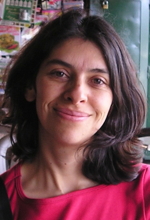 |
From Sounding Underground to Networked Migrations: listening that dislocates and integrates physical mobilities
Abstract :
I have the tendency to imagine multiple territories and perspectives as creating one shared space where physical and cultural borders overlap and transform. In this talk, I will address the elements involved in the creation of “Sounding Underground”: an Internet-based environment composed of individual journey experiences of metro passengers that, when listened to together through interactive means, abstract the collective feeling and meaning of the underground commuting experience. A derived artwork, the improvisation “Listening and Remembering” uses the same elements but in a co-located real-time performance, creating a different environment, one made up of voices that respond collectively to the soundscape.
These two works inspired a new project called “Networked Migrations”, which explores, through the use of telematic performance, the in-between sonic space that emerges through the process of geographical dislocation. All three of these experiences, understood as Internet auditoriums, open avenues for a listening that dislocates familiar sonic environments and a listening that creates a location for a space perceived as lost or not existent, within the experience of migration.
back to programme — back to participants
Ximena Alarcón is a new media artist who focuses on listening to social context related sound, connecting it to individual and collective memories. She completed a PhD in Music, Technology and Innovation at De Montfort University and was awarded with The Leverhulme Trust Early Career Fellowship 2007-2009 to develop “Sounding Underground” at the Institute of Creative Technologies. There, in 2010, she worked as a Programme Leader for the Masters in Creative Technologies. Deep Listening practice and telematic musical performance are current interests that expand both the connections to other territories and the social and aesthetic possibilities of working with the migratory experience. Since October 2011, she works in Creative Research in Sound Arts Practice - CRiSAP, at the University of the Arts London, as a Research Fellow, developing her project “Networked Migrations – listening to and performing the in-between space”.
Recent publications:
- Alarcón, X. "Listening and Remembering: Networked off-line improvisation for four commuters" in CITAR Journal of Science and Technology of the Arts, Revista de Ciência e Tecnologias das Artes. Issue 3, Autumn 2011. Portuguese Catholic University:Porto
- Alarcón, X. "Sounding Underground: Listening, performing and transforming the commuting experience". Sensate Journal. A Journal for experiments in critical media. [on-line publication]. http://www.sensatejournal.com/2011/03/ximena-alarcon-sounding-underground/ Incubated at the Sensory Ethnography and MetaLab (at) Harvard , 2011
- Alarcón, X. < http://soundingunderground.org> [online environment] 2009
- Alarcón, X. "An Interactive Environment derived from commuters' memories of the soundscape: a case study of the London Underground." PhD Thesis. De Montfort University: Leicester, 2007
|
| |
--> http://soundingunderground.org/
--> http://www.crisap.org/
|
| |
|
Julien Ottavi
 |
L'écoute distanciée ou le temps des machines
Distance listening or synchronizing to the machines
Abstract :
Si Alfred Tomatis nous dit que “l'oreille est un organe dont nous avions été initialement munis pour entendre et localiser les bruits” tout en proposant le concept “d'oreille directrice”, il s'agirait alors dans cette conférence d'énoncer un autre rapport à l'écoute, celui non pas de ses possibilités de localisation mais bien celles de sa distance vis à vis du son/bruit.
Le contexte de production d'un son ne représente pas son essence, de même il n'y engage pas à priori sa réception. Il s'agit de montrer à travers quelques projets de transmission audio (flux) et de création sonore machinique (automation) que les champs de l'écoute perdent de leur déterminisme post-contemporain. Dans la continuité des pièces de John Cage sur l'indétermination, les éco-systémes électroniques et numériques de David Tudor, des croisements qui s'opèrent aujourd'hui avec la pensée et les pièces musicales d'Erik Satie ou de Brian Eno sur la musique d'ameublement et les systèmes génératifs purement synthétiques de John Bischoff ou de Michael Koenig, nous sommes en train d'élaborer d'autres manières d'écouter, non déterminées, continues, et distanciées du contexte de production et de la capacité de l'oreille directrice à localiser et contrôler sa mécanique.
La création sonore et la musique dans leur modernité sont depuis plus d'un siècle étroitement liées à leurs conditions techniques. Il y a comme le dit Heidegger une essence de la technique, non pas en ce qu'elle incarne cette chose mais en ce qu'elle est un moyen pour certaines fins et ainsi qu'elle y représente autant une activité humaine en soi : “La Fabrication et l'utilisation d'outils, d'instruments et de machines font partie de ce qu'est la technique. [...] L'ensemble de ces dispositifs est la technique. Elle est elle-même un dispositif (Einrichtung), en latin instrumentum.”
Ces nouvelles pratiques de flux, de transformation et de manipulation d'un contexte sonore par des modes automatisés, instrumentalisés à travers des serveurs, systèmes programmatiques et des interfaces de contrôle en ligne ou dans le cadre d'installation composent une nouvelle essence de la création sonore et musicale : tout un agencement de techniques et de dispositifs inter-connectés qui influencent nos modes d'écoutes et changent la façon de composer avec les son/bruits.
back to programme — back to participants
A mediactivist, artist-researcher, composer / musician, poet and tongues destroyer, experimental film maker and anarchitect, founder and member of Apo33, Julien Ottavi is involved in research and creative work, combining sound art, real-time video, new technologies and body performances. Since 1997, he develops a composition work using voice and its transformation through computer. Active developer of audio/visual programs with Puredata, he has also developed since many years DIY electronics (radio transmitters, oscillators, mixers, amplifiers, video transmitters...etc) in the perspective of knowledge sharing on technological development. Main developer for the Gnu/Linux operating system APODIO for digital art and A/V & streaming diffusion. His practices is not limited to the art spheres but crosses different fields from technological development to philosophy / theoretical research, biomimetic analysis & experimentation. Since many years he reflects on the relations between experimental practices and collective practices within the creation of autonomous collective groups, putting in question the authorship strategy of the “art ideology”.
Regular collaborators : Jenny Pickett, Brandon Labelle, Keith Rowe, Kasper T. Toeplitz, Jerome Joy, Joachim Montessuis, Achim Wollscheid, Zbigniew Karkowski, Randy Yau, Ilios, Dominique Leroy, Dion Workman, Mike Bullock, Phill Niblock, Seth Cluett, KKnull, Jean-Louis Costes, etc.
Julien Ottavi has exhibited, performed and presented his work extensively over the last 15 years.
He is part of a generation of audio artists to emerge in the 90\`s that indicated some of the directions that music and soundart is taking. While at art school, he organized a series of concerts, bringing international artists from the experimental scene to Nantes, drawing touring musicians to movements happening outside of Paris. This became not just a destination but a nexus for collaborations. This resulted for example in the group Formanex to perform graphical scores of electro-acoustic music, and in Apo33, an artists collective to facilitate, nurture, and disseminate creative audio practice. In this way, Julien represents the energy and initiative of a present day artist – activist through practice, organizing as performance, publishing as networking, open source and open aesthetic. This fluidity of working across boundaries of style and role are seen in his music, physical with computer, performative and reflective. (introduction by Atau Tanaka)
Médiactiviste, artiste-chercheur, poète, théoricien et arracheur de langue, compositeur / musicien, réalisateur de films expérimentaux et performeur (corps & mouvement), etc. Membre fondateur d’Apo33 (laboratoire artistique, technologique et théorique transdisciplinaire), Ecos (Eco-création, observatoire du biotope) et activateur des labels Noise Mutation et Fibrr Records (production cd/web - open recordings), Julien Ottavi développe un travail de recherche et de création croisant art sonore, poésie sonore, nouvelles technologies, bricolage de dispositifs électroniques et performance physique. Actif dans le mouvement du libre, il développe la distribution multimédia Gnu/Linux Apodio. Sa pratique d’écriture musicale se décline autour de performances machiniques avec la mise en place de systèmes de composition programmatique où le programme informatique devient la partition. De même à travers le corps toujours au centre à la fois comme animalité, ou comme être à soi et aux autres, il met en action de nombreuses performances sur le devenir du corps, le corps mutant, le corps et la voix, le corps urbain, etc pouvant osciller entre situation urbaine ou contexte de workshop. Mouvement d’aller et retour dans l’écriture, le texte et le langage ont aussi une grande importance dans sa pratique, expérimentation théorique et poétique, de la page au dire, il a écrit plusieurs textes autour des pratiques sonores, art et mouvements du libre mais aussi sur le hacking, la dérive et la perte du langage. Au-delà des médiums et des catégories, l’activation et la mise en abîme d’énergies, de concepts et de forces par l’expérience est une de ses manières de pratiquer la création dans ses réalités matérielles, sociales, sensorielles, sensibles et conceptuelles. Depuis plus de 15 ans il diffuse sa musique, ses performances, conférences, écrits et installations sur la scène internationale.
Il collabore régulièrement avec des artistes renommés comme Jenny Pickett, Brandon Labelle, Keith Rowe, Kasper T. Toeplitz, Jerome Joy, Joachim Montessuis, Achim Wollscheid, Zbigniew Karkowski, Randy Yau, Ilios, Dominique Leroy, Dion Workman, Mike Bullock, Phill Niblock, Seth Cluett, KKnull, Jean-Louis Costes, etc.
|
| |
--> http://apo33.org/
--> http://www.noiser.org/
|
| |
|
Laurent La Torpille
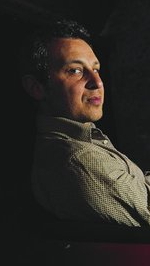 |
back to programme — back to participants
Laurent La Torpille dedicates himself to music, graphics and the creation of dynamic environments, focusing on real time interactions of images and sounds. His work is protean and focuses on plastic research, placing the individual and new technologies at the heart of the creation process.
Laurent La Torpille se consacre à la musique, au graphisme et à la création d’environnements dynamiques, privilégiant les manipulations en temps réel de l’image et du son et leurs interactions. Protéiforme, son travail s’oriente vers des recherches plastiques qui placent l’individu et les nouvelles technologies au cœur des processus de création.
|
| |
--> http://lols.free.fr/
|
| |
|
Peter Gena
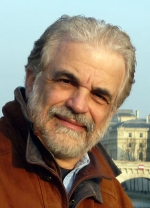 |
back to programme — back to participants
, Ph.D studied music composition with Morton Feldman, Lejaren Hiller. His work of various media have been presented extensively in North and South America, Europe, Asia, and Australia. Performances/installations include works presented at Les Nuits Numériques #7-Nanomonde at Le centre culturel Saint-Exupéry in Reims; Espace Sextius / Seconde Nature, Aix-en-Provence; Centro Andaluz de Arte Contemporàneo (CAAC); Seville, Spain, The Art Students League of New York, Computing Music IV (Cologne 2006), The Pandemic Night/La Notte Bianca (Milan 2006), Festival d'Automne (2004), Paris; Museo Nacional de Bellas Artes, Buenos Aires; the Berkeley Art Musuem (2003); Mini to the Max (2002), at the Brisbane Powerhouse, Australia; the Universidad de Salamanca, Spain, (2002); Arte al Centro 2001, at Cittadellarte/Fondazione Pistoletto, Biella; The National Gallery of China, Beijing (2001); Ars Electronica 1999, Linz; Aspekte Salzburg 1997; The International Computer Music Conference, Hong Kong; L.A.C.E., Los Angeles; San Juan University and the Poncé Museum of Art, Puerto Rico; Akademie der Kunst, Berlin; Herbst Theater, San Francisco; the Asian Institute for Liturgy and Music, Quezon City, Phillipines, The Ferienkurse f¨r Neue Musik in Darmstadt, Germany; the Merkin Concert Hall and Lincoln Center in New York, the 1991 Sao Paulo Bienal, New Music America 1981, 1982 & 1990. Similarly, as a pianist he has publicly performed many of his own works as well as those of others.
Gena's publications include, Freedom in Experimental Music: the New York Revolution (TriQuarterly 52); A John Cage Reader, in celebration of the composer's 70th Birthday (C.F. Peters Inc., NYC, 1983 [hardcover]); John Cage and the New York School: A Hyperlecture/Conversation (Warsaw Contemporary Art Museum, 1994) and a contribution to The Waltz Project (Nonesuch Records), choreographed by Peter Martins and in the repertory of the New York City Ballet. His essay Cage and Rauschenberg: Purposeful Purposelessness Meets Found Order accompanied the exhibitions, Robert Rauschenberg: The Early 1950s,and John Cage: Scores from the Early 1950s, shown at the Museum of Contemporary Art in Chicago. A paper, A Physiological Approach to DNA Music, was presented and published at CADE 2001, in Glasgow; and at the Art and Science Global Symposium, Tsinghua University, Beijing.
Since 1983, Gena has been a Professor at the School of the Art Institute of Chicago, where he teaches electronic and computer music, music history, computer programming, and interdisciplinary courses. Gena is decorated by the French government at the rank of Chevalier dans l'Ordre des Palmes Académiques.
Peter Gena, Ph.D. a étudié avec Morton Feldman, Lejaren Hiller. Ses oeuvres ont été présentées de nombreuses fois Amérique du Nord et du Sud, Europe, Asie, et Australie (voir plus haut). En tant que pianiste et interprète, il joue ses propres oeuvres ainsi que celles d'autres compositeurs.
Les publications de Peter Gena comprennent plusieurs articles: Freedom in Experimental Music: the New York Revolution (TriQuarterly 52); A John Cage Reader, pour la célébration du soixante-dixième anniversaire de John Cage (C.F. Peters Inc., NYC, 1983); John Cage and the New York School: A Hyperlecture/Conversation (Musée d'art contemporain de Varsovie, 1994) et une contribution à The Waltz Project (enregistré sous le label Nonesuch). Peter Martins a fait une choréographie pour le répertoire du ballet de New York City. Son essai "Cage and Rauschenberg: Purposeful Purposelessness Meets Found Order" a accompagné les expositions, Robert Rauschenberg: The Early 1950s, et John Cage: Scores from the Early 1950s, montrées au musée de l'art contemporain de Chicago. Un exposé, A Physiological Approach to DNA Music, (une approche physiologique à propos de musique générée à partir de séquences numériques ADN), a été présenté et publié à CADE 2001, à Glasgow; et au Colloque Global d'art et Science à l'université de Tsinghua, Pékin.
Depuis 1983 Peter Gena est professeur à la School of the Art Institute of Chicago, où il enseigne la musique électronique et assistée par ordinateur, l'histoire de musique, la programmation informatique et des cours interdisciplinaires. Gena est décoré au rang du Chevalier dans l'Ordre des Palmes Académiques.
|
| |
--> http://www.petergena.com/
|
documentation and
Photos: Locus Sonus lab and all.
|
